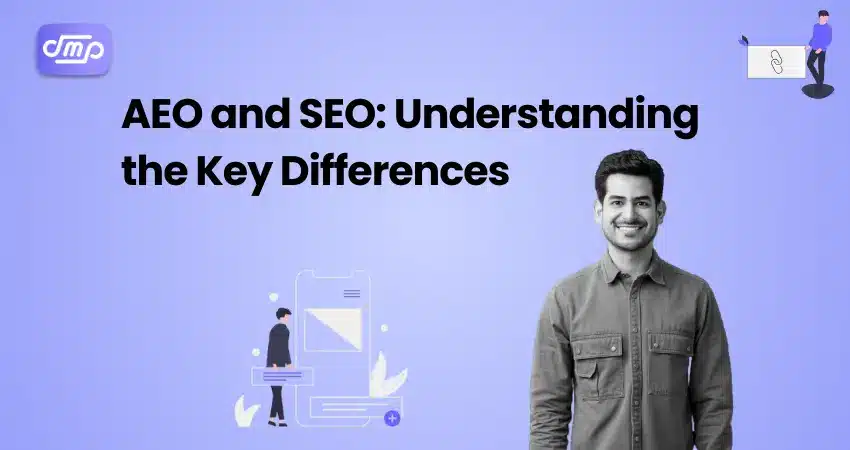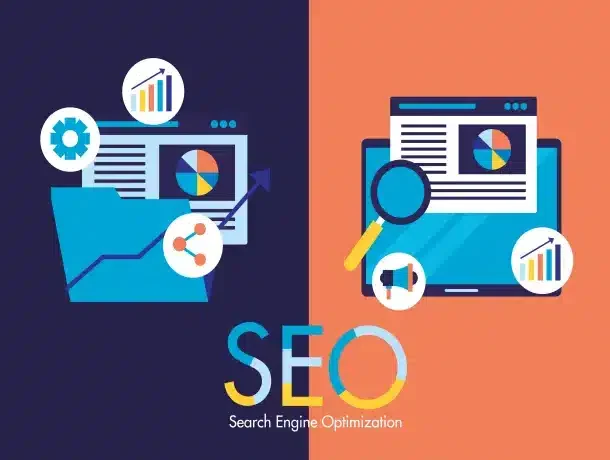
- February 21, 2025
- Digital Marketing, Keyword Research
- Search Engine Optimisation (SEO)
Table of Contents
By combining AEO and SEO, businesses can rank higher on search engines, capture AI-driven searches, and improve user engagement and conversions—ensuring long-term digital success in an evolving search landscape.
SEO (Search Engine Optimization) is the practice of improving a website’s exposure in search engine results pages (SERPs). It focuses on keyword optimization, backlinks, technical upgrades, and content quality to increase organic traffic from search engines such as Google.
AEO (Answer Engine Optimization) is the discipline of optimizing material to deliver clear, concise replies to user questions, primarily for voice search and AI-powered assistants such as Google Assistant, Siri, and Alexa. It focuses on structured data, FAQ format, and natural language processing (NLP) to ensure content appears in featured snippets and zero-click searches.
While SEO tries to rank better in search results, AEO focuses on providing immediate responses, making both necessary for a comprehensive digital strategy.
Understanding the distinctions between SEO (Search Engine Optimization) and AEO (Answer Engine Optimization) is critical in today’s digital scene, as search behavior is always changing.
- Rise of AI and Voice Search: With the increased use of voice assistants such as Alexa, Siri, and Google Assistant, more people are looking for quick, spoken responses rather than scrolling through search results. AEO guarantees that information is optimized for AI-powered searches.
- Zero-Click Searches: Google prioritizes featured snippets and direct replies, decreasing the need for consumers to click on links. AEO assists firms in securing these top ranks, assuring awareness even without traditional rankings.
- Traditional Search is Still Important: While AEO is expanding, SEO remains critical for website traffic, ranking, and authority building. To maximize reach, engagement, and conversions in an AI-driven world, brands must optimize for both long-form SEO content and direct-answer AEO formats. Failure to do so may result in missing out on potential customers.
AEO vs. SEO: Key Differences
Feature | SEO (Search Engine Optimization) | AEO (Answer Engine Optimization) |
Primary goal | Ranking higher on search engine results pages (SERPs) | Providing direct answers to user queries via AI-driven assistants and featured snippets |
Search behaviour | Users type keywords and browse results | Users ask questions via voice search or conversational AI |
Content Format | Long-form, keyword-rich content | Short, precise, and question-based content |
Optimization Focus | Keywords, backlinks, meta tags, technical SEO | Structured data, FAQ schema, natural language processing (NLP) |
Ranking Factors | Relevance, authority, backlinks, page speed, mobile-friendliness | Directness, accuracy, schema markup, AI-driven interpretation |
User Engagement | Users click on links and explore | Users receive answers instantly, often without clicking a link |
Best for | Increasing website traffic, brand authority, and lead generation | Enhancing visibility in AI-driven searches, voice search, and zero-click results |
Why You Need Both AEO and SEO
- SEO boosts website traffic and brand authority: SEO helps businesses rank higher on search engine results pages (SERPs), resulting in more organic traffic. It increases brand credibility and authority through backlinks, content quality, and domain trust. SEO is critical for long-term digital success, as it generates constant leads and money.
- AEO optimizes AI and voice search: AEO makes businesses visible in voice searches and AI-powered questions (Google Assistant, Siri, and Alexa). It boosts your chances of appearing in featured snippets, which improves brand discoverability. Helps capture zero-click searches, in which visitors receive fast answers without having to visit a website.
- Search trends are changing: Over half of all online searches are now voice-based, making AEO critical. Google is transitioning toward conversational AI and structured data, emphasizing succinct, direct responses. Businesses that rely solely on SEO may lose visibility in AI-powered search experiences.
- Combining AEO and SEO maximizes conversions: SEO drives website traffic, leads, and new customers. AEO improves engagement by offering immediate answers, hence increasing trust and brand recognition. Together, they create a well-rounded search strategy that ensures higher rankings and AI-driven visibility.
AEO and SEO complement each other by driving traffic to your website and making your content discoverable through AI-powered searches. To stay ahead, firms must combine both techniques to create a future-proof digital presence.
Optimizing Both AEO and SEO

To increase online visibility, firms must balance SEO (Search Engine Optimization) with AEO (Answer Engine Optimization) techniques. Here’s how to optimize for both.
1. SEO Optimization Strategies:
- Keyword Research and Content Optimization
- Use high-volume keywords and long-tail queries.
- Create high-quality, detailed content that addresses user intent.
- Optimize your blog entries, landing pages, and service pages.
On-page SEO Best Practices
- Optimize the meta titles, descriptions, headers (H1, H2, etc.), and internal links.
- Use organized formatting to ensure that your material is readable.
- Improve page speed, mobile friendliness, and UX design to increase engagement.
Link Building and Authority Growth
- Get high-quality backlinks from authoritative websites.
- Create guest posts, HARO answers, and industry collaborations.
- Improve your social media presence to attract referral traffic.
Technical SEO enhancements
- Fix broken links and orphaned pages.
- Address broken links, orphan pages, and duplicate content issues.
- Set up HTTPS security, XML sitemaps, and canonical tags.
- Improve the core web vitals (page speed, interactivity, and visual stability).
2. AEO Optimization Strategies:
Use Structured Data and Schema Markup
- Implement the FAQ, How-To, and Review schema to improve your chances of appearing in featured snippets.
- Optimize for knowledge graphs and AI-powered search results.
Optimize for voice search and conversational queries
- Create material that is concise, conversational, and answer-based.
- Use question-based terms (e.g., What is…?). How do I…? What is the best way to…?
- Use natural language processing (NLP) to match voice search behavior.
Use FAQs and featured snippets
- Include direct, precise answers at the start of the content.
- To facilitate scanning, organize content into lists, bullet points, and tables.
- Ensure that the replies are clear, authoritative, and easy to read aloud.
Optimize for AI-powered assistants and zero-click search
- Create summary sections from which AI can pull answers.
- To match voice search behavior, provide concise, to-the-point responses.
- Improve E-E-A-T (Experience, Expertise, Authority, and Trustworthiness) to increase credibility.
Combining AEO and SEO for Maximum Impact

To increase online visibility and react to changing search patterns, firms must incorporate both AEO and SEO into their digital strategy. SEO aims to improve search engine rankings by optimizing content, keywords, and backlinks, resulting in more organic traffic and conversions. Meanwhile, AEO ensures that information is formatted for AI-powered searches, such as voice assistants and featured snippets, to provide rapid and direct responses to user questions.
Businesses that combine both approaches can target traditional search results as well as upcoming AI-powered platforms, ensuring that they capture users across a variety of search habits. Structured data, schema markup, and concise FAQs improve AEO effectiveness, but long-form content, keyword optimization, and link building boost SEO ranks. Also, optimizing for voice search, conversational queries, and mobile-first experiences. Queries and mobile-first experiences bridge the gap between AEO and SEO, catering to current search patterns. A well-balanced approach enables organizations to sustain greater search ranks, increased engagement, and future-proof digital exposure in an AI-driven environment.
Conclusion
As search engines evolve and AI-powered search experiences become more common, businesses must adjust their strategy to remain visible and competitive. While SEO (Search Engine Optimization) is still essential for ranking in traditional search results and driving website traffic, AEO (Answer Engine Optimization) is becoming more significant for voice searches, AI-powered assistants, and zero-click results. Rather than selecting between the two, combining AEO and SEO guarantees that your material reaches the broadest potential audience, whether they are browsing search engine results or looking for quick, spoken responses.
Businesses can future-proof their digital presence and increase their online reach by using structured data, optimizing for featured snippets, developing authoritative long-form content, and improving voice search readiness. Ultimately, a combined AEO and SEO strategy is the key to long-term exposure, engagement, and conversions.











